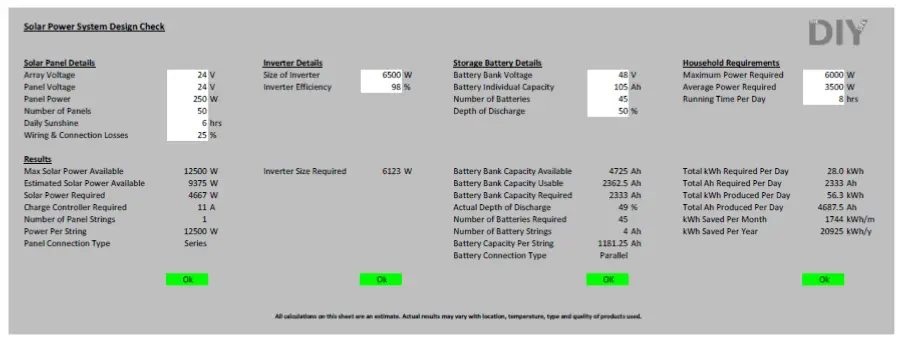This spreadsheet enables you to check your designed solar power system before you purchase the components to ensure that they are adequately sized. This spreadsheet should be used in conjunction with the guide on switching to solar power.
How To Use This Spreadsheet
The spreadsheet is broken up into four sections which check your solar panels, inverter, storage batteries and household requirements against each other to ensure that they are all adequately sized.
Solar Panel Details
- The array voltage is the total voltage of your panels connected in series. For example, if you have two 24V panels connected in series then your array voltage is 48V. If they are connected in parallel then the array voltage is still only 24V.
- The panel voltage is the rated voltage of each individual panel.
- The panel power is the maximum power output of each individual panel.
- The number of panels is the total number of panels your are using.
- The daily sunshine is the estimated time your solar panels are exposed to full sunshine in one day.
- Wiring and connection losses represent the power losses sustained by your distribution system. Typically a system where the inverters are close to the panels will have low losses 10-15% where ones further away, ie in a basement will have higher losses, around 20-30%.
Inverter Details
- The size of the inverter is the maximum continuous power output the inverter can provide.
- The inverter efficiency is usually around 95% to 99% for good quality pure sine wave inverters and around 60% to 80% for modified sine wave inverters.
Storage Battery Details
- The battery bank voltage is the total voltage of your batteries connected in series. For example, two 12V batteries in series provide a bank voltage of 24V while two 12V batteries in parallel provide a bank voltage of 12V.
- Battery individual capacity is the capacity in amp hours of the individual batteries used in your battery bank.
- The number of batteries is the total number of batteries used in your battery bank irrespective of the connection types.
- The depth of discharge is the maximum amount you wish to discharge the batteries to as a percentage of the original capacity. For example, it is not recommended to discharge deep cycle lead acid batteries to less than 50% of their original capacity. The higher the percentage, the longer the batteries will last however more batteries will be required to provide the same duration of power output.
Household Requirements
- Maximum power required is the maximum power your household draws at any given time in the day. This is purely for the solar power system, so if your stove or water heater is not connected to the system then these can be neglected.
- The average power required is the average power consumption for your household during the time frame the solar or backup power system is running.
- The running time per day is how long your solar or backup power system is expected to run per day. For example, if you are only using your system to power your lighting in the evenings then this figure would be around 3-5hrs per day while if you require it to run your refrigerator then this figure would be 24hrs per day.
Important Outputs
- If any of the markers underneath the relevant section indicate that the section is Not Ok, a dialogue will display the problem. This should be corrected to ensure that your system is adequately sized.
- The bottom right figures give you estimates on the savings your can expect to make from your solar power system in kilowatt hours per month and per year. These figures should be multiplied by your local electrical tariffs to get the actual monetary values.


